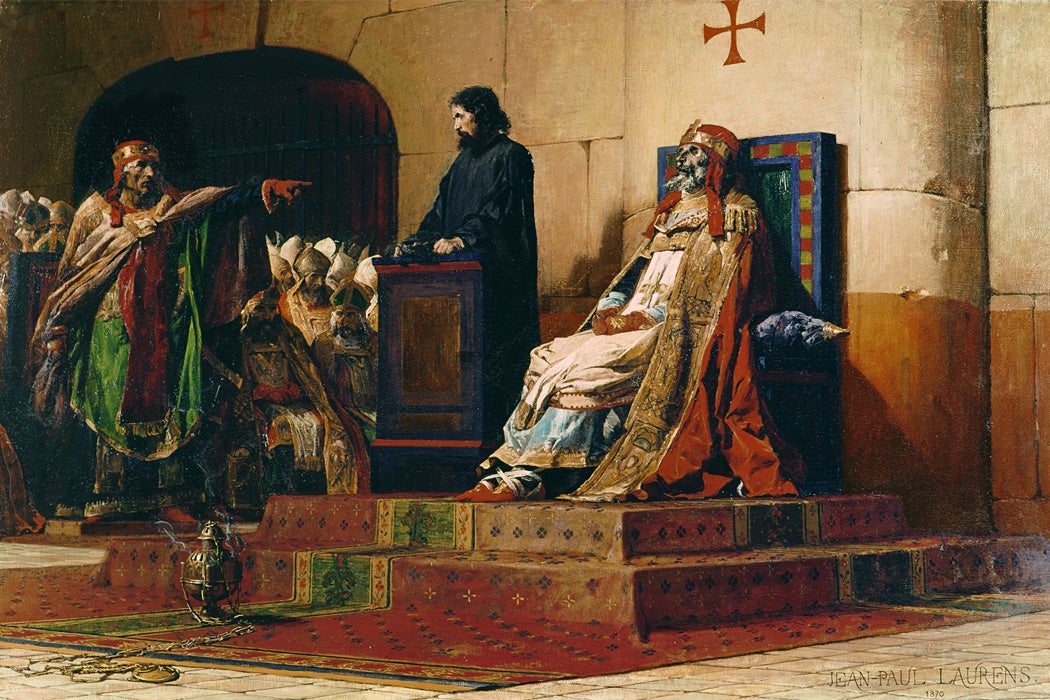In 897, the Vatican saw one of the most bizarre episodes in history: The corpse of a pope was put on trial by his living successor. Pope Formosus, dead for a few months, was hardly qualified to defend himself in a court of law. Nonetheless, Pope Stephen VI had the body disinterred, dressed in its ecclesiastical robes, and propped up on the papal throne to stand trial. He even appointed a deacon to speak on the corpse’s behalf.
While Stephen VI hurled accusations at Formosus, the accused remained stoically silent, as might be expected of a corpse. In the words of the historian George Ives, “The old man’s body, like a monstrous doll, might nod and bend while the attendants supported it, or collapse in a ghastly bundle if they left it alone, but it made no sound; and the deacon would probably be wary in his defence, for there were dark holes nearby, other than sepulchres.”
In the middle of the trial, an earthquake shook the room. A clear sign from God, according to the embellishments of later commentators:
For the stones themselves, execrating such a monstrosity, then cried out with their own voice by knocking against each other, that they would more willingly suffer spontaneous ruin, than that the Roman Church should remain depressed by so great a scandal.
But if the stones cried out, Stephen VI paid them no mind. He persisted with his case, and the dead pope was found guilty of usurping the papacy. Stephen VI declared all his acts as pope null and void: all consecrations, all appointments, all ordinations were undone. Formosus’ body was stripped of its rich garments and dressed in rags. Three of his fingers—the fingers of the benediction, with which, in life, he had given blessings—were cut off, and his body was cast into the Tiber River.
Stephen’s victory didn’t last long, however. Within a few months, he was imprisoned and then strangled to death. His reign lasted a little over a year.
In this era, being elected pope was a little like being diagnosed with a deadly disease. You could put off your fate with some skillful political maneuvering, but the prognosis wasn’t good. This was largely because popes had the power to crown the Holy Roman Emperor, meaning that any new pope was immediately plunged into a high-stakes game of intrigue with their life on the line. Stephen’s successor, Romanus, lasted only ninety-two days. Romanus’ successor, Theodore II, lasted less than three weeks.
As for Formosus, his body was plucked from the Tiber by a fisherman, and returned to its tomb in St. Peter’s Basilica. A contemporary chronicler, Liudprand of Cremona, wrote:
[W]hen he was afterwards found by fishermen and carried to the Church of the blessed Prince of the Apostles, certain images of the saints, with veneration, saluted him, placed in his coffin; for this I have very often heard from most religious men of the city of Rome.
By throwing his enemy in the Tiber, Stephen VI was taking part in an ancient tradition. For centuries, the Tiber River was where the ancient Romans disposed of their most infamous criminals. The flow of the Tiber bore away the political rivals of emperors and early Christian martyrs. It carried away the bodies of reviled emperors, condemned to damnatio memoriae. It was even, according to some legends, the place where Pontius Pilate met his ignominious end. For thousands of years, the Tiber was where you threw anyone you wanted to permanently exile, from life, from society, even from memory.
Once a Week
Why did Stephen VI go to such lengths to destroy an enemy who was already dead? To understand this, you have to understand the importance of relics in the medieval era. The dead body of a holy person was more than rotting flesh; it was transformed by death into a holy relic, a source of miraculous power. These relics were the center of religious life. As the historian Lionel Rothkrug writes:
Every church, every altar, every nobleman, every king, every monastery, had relics, sometimes in great quantity. They were brought out to authenticate the work of justice; they were carried out with the armies; they were borne in procession to encourage the drooping crops; they were instruments of state, of law and order, of personal well-being. Even the pope, whatever theoretical claims were made for him, in practice owed most of his authority to the fact that he was the guardian of the body of St. Peter.
Through their relics, saints continued to be members of the community: hearing the pleas of petitioners, responding to the needs of the people with divine intercession, and receiving their gifts of thanks. They were participants in the daily lives of the people that venerated them. In this sense, they were still alive.
It was this continued presence that Stephen VI sought to deny his predecessor. With his body lost at sea, no one could venerate his relics. Oddly enough, it was by treating Formosus as if he were still alive—propping him up on a throne, putting him on trial, subjecting him to a posthumous execution—that Stephen VI sought to kill him for good.







